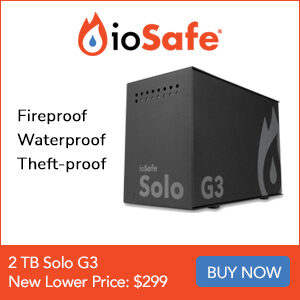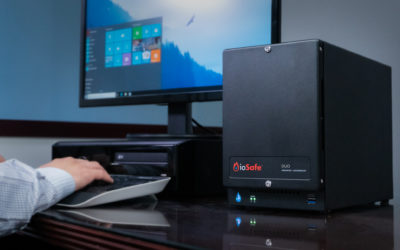Protecting Data as a Digital Nomad (Part 3)
Photo: Annie Wynn
In this three-part series, we’re taking a look at why backups matter, especially for digital nomads, and how to create and execute a backup strategy that fully protects your digital life.
Whether you’re full-timing in an Airstream trailer or hunkered down in a country cabin, you need a well-designed backup strategy and the equipment to execute that strategy. As we covered in part two of this series, we recommend the Full-Coverage 3-2-1 backup strategy: three copies of each file, two local copies (one on your working drive and one on a different drive or backup device), and one copy offsite.
Let’s Get Local
 Let’s face it, the key to a solid backup strategy is really having a local backup that is secure and can stand up to disastrous things like fire or water. That rules out the whole “copy things to a flash drive and throw it in the bottom drawer” approach.
Let’s face it, the key to a solid backup strategy is really having a local backup that is secure and can stand up to disastrous things like fire or water. That rules out the whole “copy things to a flash drive and throw it in the bottom drawer” approach.
What makes a safe, secure local backup? The short answer is automated software and secure, resilient hardware.
The software you use for backing up your data needs to be automatic. It shouldn’t depend on you remembering to choose a menu item or flip a switch. Whether you use something like the Windows 10 Backup (in Settings), Time Machine in macOS, other commercial backup software or write your own, it also needs to be reliable. And bonus points if it can warn you the nightly backup hasn’t been done, so you know to fix whatever broke.
The hardware you select for backing up your data might be the one thing people think about the least. They buy an external hard drive, hook it up, set up the software, and mostly forget about it. I know because that’s what I did as a digital nomad. It was only when a friend’s RV caught on fire that I realized my backup strategy needed some serious improvement, starting with the hardware.
Dodging Disasters
Every digital nomad on the road has met the concept of a “go bag” whether it’s due to tornado watches in the Southeast or wildfires in the West. Usually, a go bag is what you can pack in under ten minutes and you grab only what you cannot live without or replace easily: IDs, credit cards, phone (and charger), laptop (and charger), hard copies of specific papers, etc. and maybe a few special items close to your heart. Most people in the controlled panic that involves packing a go bag and moving to a safe place don’t think about their backup disks.
I know I didn’t the first three times I got caught in tornado warnings. I had visions of my trailer acting like Dorothy’s house in the Wizard of Oz. I had my laptop with me, but it had been at least a week since I’d done a cloud backup and my local backup disk was in a cupboard in my trailer. I was juggling a handful of client projects with impending deadlines so I couldn’t afford to lose a single file. Cue the better backup strategy, starting with better local hardware.
After the tornado warning was over, I got online and did my cloud backup and then I started researching better local backup solutions.
What exactly makes for a rock-solid, reliable local backup? It’s actually pretty simple. Ask yourself these five questions:
- Is it easy to use? If you don’t use your backup system because it’s a pain, it really isn’t doing you any good at all.
- Is it reliable? The manufacturer should stand behind their product with a solid warranty.
- Does it protect as well as store your data? My “solution” stored my data, but it didn’t protect me at all against fire or water damage.
- Does it include data recovery? If the drive fails, or it gets damaged by fire or water, there should be a way to recover the data. ioSafe, for example, offers its Data Recovery Service for disks it sells, covering all sorts of data loss.
- How old is the hardware? Even with the best device, you should be thinking about replacing it after five years of steady usage. Even though we think digital data floats through the ether, the devices it lands on are physical objects subject to a lifespan.
For digital nomads, especially ones with smaller rigs like mine (a 17-foot travel trailer) or a van, finding space and power for a local backup solution like ioSafe’s Solo G3 may seem like a lot of work but once it’s set up, you’re good to go. It’s easy, reliable, and protects your data from all kinds of potential disaster scenarios. From work files to photos and digital memories, it’s a great feeling to know all your digital assets are well-protected.
Annie Wynn
Guest Blogger
Annie Wynn, our guest blogger for this series, has been a digital nomad for over five years, traveling the US and Canada in her Alto trailer. You can follow her adventures at www.wynnworlds.com.
Related Blog Posts
Off-Facebook Activity is Here: 3 Facebook Data Privacy Settings You Can Change Right Now
On Data Privacy Day 2020, Facebook launched a new privacy control tool for users called Off-Facebook Activity. Much like...
Power Outages are the New Normal in Our California Community
My small community—nestled in the foothills of Northern California—is one of 34 counties that experienced the first of...
Introducing the Fireproof and Waterproof ioSafe Duo
Today, we’re introducing the ioSafe Duo, a two-drive fireproof, waterproof storage device that is ideal for people who want...



